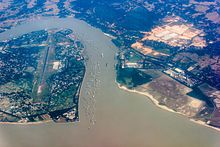Karnaphuli
| Karnaphuli River | |
|---|---|
 Aerial view of the Karnaphuli River estuary | |
 | |
| Location | |
| Countries | India and Bangladesh |
| Cities | Chittagong |
| Physical characteristics | |
| Source | |
| • location | Saithah, Mizoram, India |
| Mouth | |
• location | Bay of Bengal |
| Length | 270 kilometres (170 mi) |


The Karnaphuli River (Bengali: কর্ণফুলি Kôrnophuli; also spelt Karnafuli[1] and Khawthlangtuipui[2] in Mizo, meaning "western river" and Borgang in Chakma, meaning "Big River") is the largest and most important river in Chittagong and the Chittagong Hill Tracts. It is a 667-metre (2,188 ft) wide river in the south-eastern part of Bangladesh. Originating from the Saithah village of Mamit district in Mizoram, India, it flows 270 kilometres (170 mi) southwest through Chattogram Hill Tracts and Chattogram into the Bay of Bengal. It is the fastest flowing river in Bangladesh, after the Padma. It is said to "represent the drainage system of the whole south-western part of Mizoram."[3] Principal tributaries include the Kawrpui River or Thega River, Tuichawng River and Phairuang River. A large hydroelectric power plant was built on the Karnaphuli in the Kaptai region in the 1960s. The mouth of the river hosts the Port of Chattogram, the largest and busiest seaport of Bangladesh.
Etymology
[edit]The presence of Arab traders and merchants in the history of Chittagong led to many areas in Chittagong to have names of Arabic origin. The name of this river is thought to have come from qarnaful, the Arabic word for clove, and refers to an incident in which an Arab ship full of cloves sank in this river.[4]
Course
[edit]Chittagong City
[edit]Chittagong is situated on the banks of the Karnaphuli River between the Chittagong Hill Tracts and the Bay of Bengal. The city is a noteworthy seaside seaport city and monetary focus in southeastern Bangladesh. The Chittagong Metropolitan Area has a populace of more than 8.9 million,[5] making it the second biggest city in Bangladesh. It is the capital of an eponymous locale and division. A water treatment plant has been set up by Chittagong Port Authority to source water from the Karnaphuli river for its uses. The plant will make the port self-reliant in its water needs.[6]
Tlabung
[edit]Tlabung is situated on the banks of the Karnaphuli River in Lunglei district, Mizoram. Karnaphuli River links Mizoram with the port cit of Chittagong on the shores of Bay of Bengal. British Troops and missionaries used this route to reach Mizoram during the Colonial days. It used to take 5 days to reach from Chittagong to Tlabung on a motorboat, a distance of about 90 kilometers, after which they would travel another 35 kilometers to reach Lunglei.[7]
Transport
[edit]
The government had awarded a contract to build a two lane Karnaphuli tunnel underneath the Karnaphuli river to China Communication Construction Company (CCCC). This is the first underwater tunnel in Bangladesh. CCCC received $706 million for its services, with total costs expected to be over $1 billion.[8]
Kaptai dam
[edit]
The Kaptai Dam is the location of the Karnafuli Hydroelectric Power Station, constructed in Kaptai in 1962 and the only hydroelectric power plant in the country. An earth-filled dam on the Karnaphuli River, the Kaptai Dam, created the Kaptai Lake, which acts as the water reservoir for the hydropower station. The power plant produces a total of 230 megawatts of electricity. When then east Pakistan built the dam, Indian Prime Minister Jawaharlal Nehru didn't object even though it resulted in part of Indian side getting submerged and inflow of more than 40000 refugees.[9]
Pollution
[edit]Like many rivers in Bangladesh, Karnaphuli is heavily polluted by agricultural runoff. Reducing the amount of oxygen available and harming aquatic life in the river.[10] In 2015, a train carrying oil crashed over a tributary of the river. The spill caused environmental degradation.[11]
Aquatic life
[edit]The river is home to the Ganges river dolphin, which is an endangered species.[12] Hilsa used to be common in the river, but have nearly disappeared from the river due to pollution.[10]
Gallery
[edit]-
View from the middle of the Karnafuli
-
View of the river
-
Ships at Karnaphuli River
-
Port of Chittagong and Karnaphuli River at night
-
Tourist at Karnafuli River Cruise
See also
[edit]References
[edit]- ^ Mesbah-us-Saleheen and Sifatul Quader Chowdhury (2012), "Karnafuli River", in Sirajul Islam and Ahmed A. Jamal (ed.), Banglapedia: National Encyclopedia of Bangladesh (Second ed.), Asiatic Society of Bangladesh
- ^ Tan, Khee Giap; Low, Linda; Tan, Kong Yam; Rao, Vittal Kartik (31 December 2013). Annual Analysis Of Competitiveness, Simulation Studies And Development Perspective For 35 States And Federal Territories Of India: 2000-2010. World Scientific. p. 676. ISBN 978-981-4579-49-0.
- ^ Pachuau, Rintluanga (1 January 2009). Mizoram: A Study in Comprehensive Geography. Northern Book Centre. p. 40. ISBN 978-81-7211-264-6. Retrieved 8 August 2012.
- ^ Chowdhury, Abdul Hoque (1980). চট্টগ্রামের সমাজ ও সংস্কৃতি [Society and culture of Chittagong] (in Bengali). J.B. Chowdhury. p. 24.
- ^ E-Vision Software Limited. "Economics Landscape of Chittagong". chittagongchamber.com.
- ^ Chowdhury, Sarwar A. "Chittagong port sets up water treatment plant". The Daily Star. Retrieved 16 July 2015.
- ^ Pachuau, Joy (13 April 2015). The Camera as a Witness. Cambridge University. p. 150. ISBN 9781107073395.
- ^ "Cabinet okays Karnaphuli river tunnel project". The Daily Star. Retrieved 16 July 2015.
- ^ Bari, M Fazlul (2012). "Dam". In Islam, Sirajul; Jamal, Ahmed A. (eds.). Banglapedia: National Encyclopedia of Bangladesh (Second ed.). Asiatic Society of Bangladesh.
- ^ a b Roy, Pinaki (2 May 2015). "Hilsa spawning less and less". The Daily Star. Retrieved 16 July 2015.
- ^ "Spilled oil flows towards Karnaphuli". The Daily Star. 20 June 2015. Retrieved 16 July 2015.
- ^ "Ganges River dolphin OVERVIEW". worldwildlife.org. World Wildlife Fund. Retrieved 17 December 2015.





